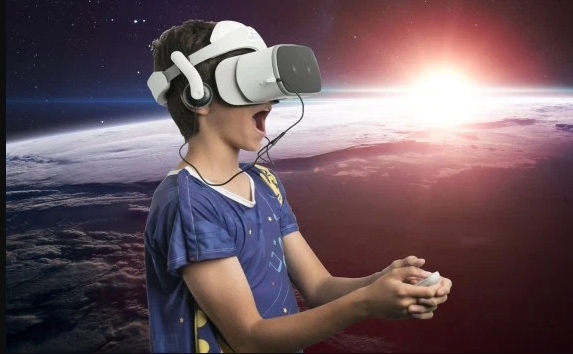
Image Credit: Justin Rosenberg / Starlight Childrens Foundation
Virtual reality’s hype is falling behind the actual growth of its mainstream audience. It is finding success in the enterprise, but the technology promised so much more than just being good for training. Critics and creators alike are left wondering if this is a technology to look out for, or is it just a “gimmick.” Insulted by the term? I used to be myself, until I took a deep dive into the origins and meaning of the word.
By definition, a gimmick is:
- to attract attention or increase appeal
- A concealed, usually devious aspect or feature of something, as a plan or deal: An offer that good must have a gimmick in it somewhere.
- A hidden mechanical device by which a magician works a trick or a gambler controls a game of chance.
Is VR an ingenious device that’s too good to be true?
I believe VR is one of the most ingenious technologies ever created. If you told me, “Hey, put this mask over your eyes and you’ll be transported to the other side of the planet.” I would say, “No way! That’s too good to be true!” I guess you could say it’s too good and it’s true. And I love the last definition, because this is exactly what we do when we create VR experiences. We are tricking the participant that puts on that HMD.
The Origins of Gimmick
So, where does the word gimmick come from? Over time, the United States has added many words to the English language — just sprinkling in more linguistic quirks to make it as unpredictable as possible. In addition to Internet, hooker, breathalyzer, motel, hangover, hindsight, lengthy, phony and fudge, “gimmick” also originated in the good ‘ol U-S-of-A. The word’s origin comes from the 1920s as a possible approximate anagram of “magic,” the original sense of being “a piece of magicians’ apparatus.”
While gimmick is clearly not a true anagram for magic, it certainly has some legs in terms of etymology. British futurist and science fiction author Arthur C. Clarke famously said, “Any sufficiently advanced technology is indistinguishable from magic” which applies to VR, in a sense. And so, given the base definition strung together, VR is a gimmick.
And it’s not the first!
A Brief History of Failed Gimmicks
In the 1920s, movies with sound were regarded with abhorrent absurdity. Mary Astor, one of the few silent film actresses to successfully transfer to “talkies” at first said talkies were “a box-office gimmick.” When it came to the advent of the television, many were skeptical of the validity of these early blocky gadgets. Film producer and head of 20th Century Fox, Darryl Zanuck, stated in 1946 that, “People will soon get tired of staring at a plywood box every night.” They could have never seen into the future to see the addictive drama of reality television in the palm of your hand.
Computers also suffered a public reluctance. In 1985, the New York Times reported laptops were on their way out, stating “…people don’t want to lug a computer with them to the beach or on a train to while away hours they would rather spend reading the sports or business section of the newspaper.”
Before it even technically existed, there were articles presenting online shopping as a gimmick. In a (sexist) TIME magazine article from 1966 titled, ‘The Futurists: Looking Forward to A.D. 2000,’ the magazine claimed: “Remote shopping, while entirely feasible, will flop–because women like to get out of the house, like to handle merchandise, like to be able to change their minds.”
Virtual reality has experienced scrutiny since its emergence — yes, oftentimes described as a “gimmick” — with a strikingly parallel critical reception to the birth and growth of cinema and television. Cynicism for each medium largely stems from overhyped numbers. Virtual reality was forecasted to reach $150 million in revenue by 2020, and every year there’s been a new report projecting extreme growth, all in the service of getting investors excited about VR — but it hasn’t hit the mainstream yet.
What Does VR’s Success Look Like?
Unfortunately the predictors have been wrong, but the tech is so right. So, how do we pedal back the overhyped numbers and reframe the perception of the growth of VR as a medium? To do so, we need to redefine success. The stats should be about the emotional experiences, not about revenue benchmarks. This is still a new medium and we can’t expect everyone to wake up tomorrow and go get an expensive headset. We need to nurture the public and slowly get them used to the unique mechanics, nomenclature and social aspects as we creators provide engaging content that get the participants to want to dive into the metaverse everyday.
Yes, monetizing and ROI are important in the long run, but from a creative and consumer standpoint — emotional and physical reactions and the memories that leave a lasting impact — these are what should dictate success for the people brave enough to create content with these new technologies. If we don’t have new engaging experiences that are continually being added to a library for participants to enjoy, then we’re not going to even have a long term industry that has the potential to create huge amounts of creative jobs.
So, while this novel device created to attract viewers is by definition a gimmick, it has the transformative power to educate, inspire, entertain and actually bring us closer together. After all, the gimmicks of today often transform into the societal tentpoles of tomorrow.
VR may be a gimmick, but that isn’t a bad thing. It takes a gimmick to make some magic!
Tom Westerlin is a Creative Director at Nice Shoes, leading all immersive experiences for the creative studio.